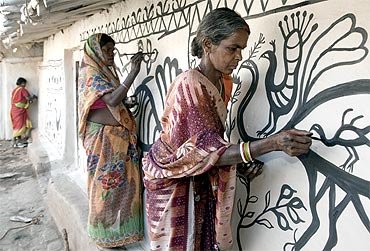Image: A courtyard in the village of Jorakath is being decked up for a wedding ceremony. The painting traditions of Khovar (for weddings) and Sohrai (for harvest festivals) has been handed down from mothers to daughters for generations but is becoming rarer as traditional mud buildings are replaced with brick construction and pressure from mining impacts traditional village life. View more slides on Rediff.com >>
The state of Jharkhand is home to one of the largest Adivasi (tribal) populations in India. It is also the location of an estimated 40% of the country’s deposits of coal, iron ore, uranium and other minerals considered essential for India’s industrial and energy needs. […]
In the early 21st century, India is experiencing unprecedented economic growth. The middle class is becoming more prosperous and numerous, the cities are rapidly expanding. But to fuel this economic boom, raw materials are being extracted by mining corporations at an ever-increasing rate from mineral-rich states in north central India inhabited by people who can claim to be the oldest dwellers in the land. […]
Can the rights of Adivasi to continue living according to their ancient traditions be accommodated in the new India?
Robert Wallis
Photographer Robert Wallis’ work on environmental, social and economic issues in Asia and other parts of the world has been widely published. You can see more of Robert Wallis’ work at www.tinyurl.com/jharkhandmultimediaThe Tribal Women’s Artist Collective (TWAC)
TWAC from Jharkhand, India preserves artistic traditions passed down from mothers to daughters. It also campaigns to protect the Jharkhand environment and ancient archaeological and rock-art sites across the state. Find out more at www.karanpuracampaign.com
Source: Panos Pictures – Photo agency specialising in global social issues
Address: https://www.panos.co.uk
Date Visited: 28 November 2023
Learn more about Jharkhand
See also
Chotanagpur | Chota Nagpur | Fact checking
Communities: Asur | Ho| Kharia | Munda | Oraon | Santal | State wise ST list (Scheduled Tribes)
Hul (Santal rebellion 1855-1856) | Tribal freedom fighters
Jharkhand | Jharkhand land rights
Video | Banam: Lutes and fiddles of the Santal people – Jharkhand and West Bengal
Video | Hul Sengel: The Spirit of the Santal Revolution (1855) – Jharkhand
Insecurity has become a “defining feature of our time,” says 2023 CBC Massey Lecturer Astra Taylor. The Winnipeg-born writer and filmmaker explores how rising inequality, declining mental health, the climate crisis, and the threat of authoritarianism originate from a social order built on insecurity. In her first lecture, she explores the existential insecurity we can’t escape — and the manufactured insecurity imposed on us from above. […]
33:18 Enclosure as a “trial run for the dispossession of Indigenous peoples [when a particular] landowner recommended fencing with hedges that did not bear fruit, so these hedges could not be put to life sustaining use. He didn’t want people to be tempted to eat for free. […] Today we take for granted that we must work a proper job. […] The history of enclosure reminds us that this arrangement is anything but natural [as] ‘wagelessness’ had to be imposed.”
Source: CBC (Radio) Massey Lectures | #1: Cura’s Gift
URL: https://www.cbc.ca/listen/live-radio/1-23-ideas/clip/16024185-cbc-massey-lectures-or-1-curas-gift
Date Visited: 28 November 2023
[Bold typeface added above for emphasis]
The notion of ‘mainstreaming’ needs to be challenged not just because Adivasi culture is being crushed, but also because Adivasi values and ways of life offer insights that the ‘mainstream’ needs: “They do so not just for themselves but for the larger good of the country and the ecological health of the world”: In support of a syllabus reflecting Adivasi knowledge systems and ways of life >>
“I would urge you not to treat the issue of human rights in isolation and pay equal attention to nursing Mother Nature which is deeply wounded by the indiscretions of human beings.” – Droupadi Murmu | Speeches by the President of India >>
Up-to-date reports by Indian journalists and commentators
To search Indian periodicals, magazines, web portals and other sources safely, click here. To find an Indian PhD thesis on a particular tribal community, region and related issues, click here >>
Search tips
Combine the name of any particular state, language or region with that of any tribal (Adivasi) community.
Add keywords of special interest (music, poetry, dance just as health, sacred grove and biodiversity); learn about the rights of Scheduled Tribes such as the “Forest Rights Act” (FRA); and the United Nations “Declaration on the Rights of Indigenous Peoples”, “Universal Declaration of Human Rights”, “women’s rights”, or “children’s right to education”.
Ask a question that includes “tribal” or “Adivasi”, for instance: “Adivasi way of life better?” (or “tribal way of life worse?”)
Specify any particular issue or news item (biodiversity, bonded labour and human trafficking, climate change, ecology, economic development, ethnobotany, ethnomedicine, global warming, hunter-gatherers in a particular region or state, prevention of rural poverty, water access).
For official figures include “scheduled tribe ST” along with a union state or region: e.g. “Chhattisgarh ST community”, “Himalayan tribe”, “Scheduled tribe Tamil Nadu census”, “ST Kerala census”, “Particularly Vulnerable Tribal Group Jharkhand”, “PVTG Rajasthan”, “Adivasi ST Kerala”, “Adibasi ST West Bengal” etc.
In case the Google Custom Search window is not displayed here try the following: (1) toggle between “Reader” and regular viewing; (2) in your browser’s Security settings select “Enable JavaScript” | More tips >>
Note: hyperlinks and quotes are meant for fact-checking and information purposes only | Disclaimer >>
See also
Adverse inclusion | Casteism | Rural poverty
Childhood | Tribal Children’s Right to Education in India
Demographic Status of Scheduled Tribe Population of India (Census figures 2011)
Fact checking | Figures, census and other statistics
Human Rights Commission (posts) | www.nhrc.nic.in (Government of India)
Search tips | Names of tribal communities, regions and states of India
“What is the Forest Rights Act about?” – Campaign for Survival and Dignity
“Who are Scheduled Tribes?” – Government of India (National Commission for Scheduled Tribes, NCST)
